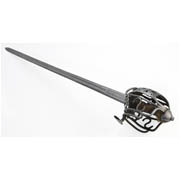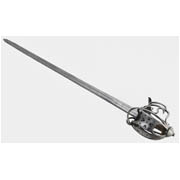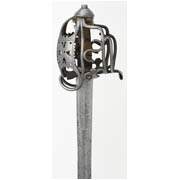Details
- Object type
basket-hilted sword; basket-hilted broadsword
- Culture/School
Jacobite
- Place Associated
Scotland (place associated)
- Date
1700 - 1710
- Materials
steel, wood
- Dimensions
overall: 160 mm x 1010 mm x 120 mm 1340 g
- Description
-
In many ways this sword is representative of the classic Scottish basket-hilted sword of the early 18th century. The unmarked basket is of a standard type made in large numbers by Stirling swordsmiths. It is composed of narrow, rounded bars of steel, with rectangular panels on either side of the font bar – these panels are punched with round holes and arrowhead-shaped piercings, and the edges of the panels have been decorated with simple filework, a form of ornament that is also typical.
However, this sword has features that make it special – the words and images that are inscribed upon the blade. On one side, just above the guard, are the words ‘Prospiretty to Scotland and no Union’, above which are depictions of a thistle and St Andrew. The words express opposition to the 1707 Act of Union, which dissolved the separate parliaments of England and Scotland and created a single parliament of Great Britain. Scottish independence was over, and many Scots objected.
We learn still more about the owner of this sword from the engraving on the other side of the blade – ‘God Bless King James The 8’, above a portrait of ‘King James VIII’. These words refer to James Francis Edward Stuart, the son of King James II of England and VII of Scotland [recte Scots], and connect the owner of this sword with one of the most famous movements in Scottish history – Jacobitism.
- ID Number
A.1954.118
- Location
Kelvingrove History Discovery Centre







